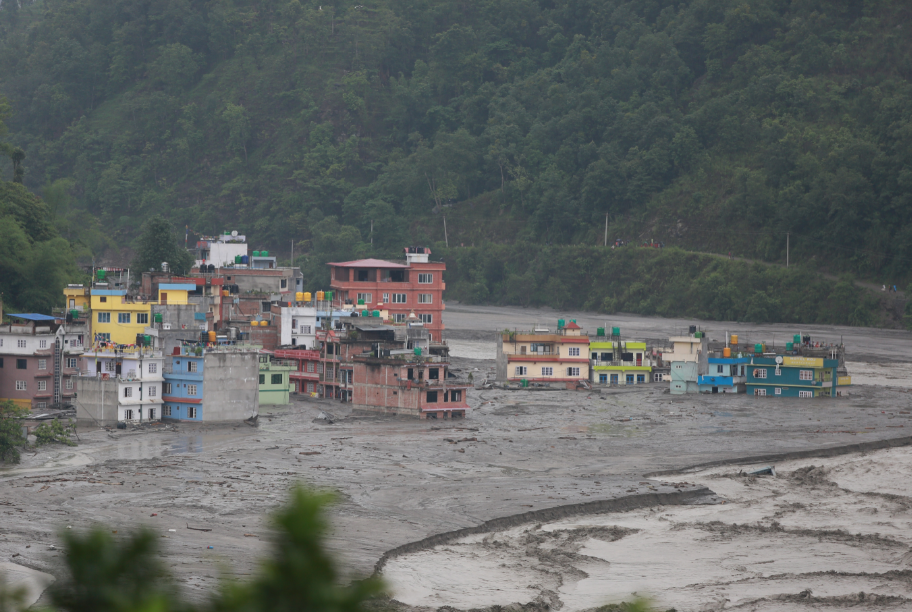Nepal is a low carbon-emitting country but bears a disproportionate brunt of its impacts.
The mountains are gradually going dark due to the fast melting of snow caused by increasing temperatures, and the frequency and intensity of landslides, floods, and avalanches are increasing. Parts of the country have been under long bouts of drought and water springs are drying up.
With rising temperatures, climate-induced disasters are likely to get worse. Disasters can’t be completely avoided but adequate measures can still be taken, say experts.
Over the past few months, Nepal has experienced unprecedented disasters, prompting authorities to take the climate crisis more seriously and urgently than before. Many disasters that took place over the past few months could be linked to climate change.
For instance, on 15 June, Melamchi Bazar of Sindupalchowk district was ravaged by a flash-flood that claimed five lives—and 20 are still missing. It damaged private and public property and wreaked havoc on the newly-completed Melamchi water supply project.
Says Anil Pokhrel, chief executive at National Disaster Risk Reduction and Management Authority, there is usually no heavy rainfall during the onset of monsoon, but this June, Sindhupalchowk experienced unprecedented amounts of rain.
Rising temperature is intensifying the earth’s water cycle and increasing evaporation, also resulting in more precipitation. Heavy rainfall across small areas is leading to large-scale floods and landslides.
On June 14, a debris flow in the Upra valley of Jomoson ravaged many villages and disrupted road access to the area. The Himalayas too have been badly hit by the effects of climate change.
On 15 November, an avalanche in the forest of Thasan Rural Municipality-2 of Mustang district swept away more than 125 yaks and injured some people.
Also read: ‘ApEx for climate’ Series | Nepal makes its case. But to what effect?
According to a report titled ‘Disaster Risk Reduction and Management, 2021’ prepared by the Ministry of Forest and Environment, about eight percent of Nepal is flood-prone and about 59 percent of its land area is landslide-prone.
On average, says the report, about 56 percent of Nepal is affected by droughts, with an average drought lasting 3.4 months (102 days) a year. The report says, “Based on the available data on losses and damage from different climate-induced disastrous events between 1971 and 2019, about 647 people on average die from climate-induced disasters in Nepal each year.”
A report prepared by Intergovernmental Panel on Climate Change (IPCC), a UN body in 2021, projected extreme precipitation to increase in major mountainous regions, with potential cascading consequences of floods, landslides, and lake outbursts.
Still another report ‘Climate Change Scenarios in Nepal’ prepared by the Nepal government, says annual precipitation is likely to increase in both the medium- and long-term: by 2-6 percent in the medium-term and by 8-12 percent in the long-term.
Similarly, the average annual mean temperature is likely to rise: it could increase by 0.9-1.1degrees Celsius in the medium term and 1.3-1.8 C in the long term. The temperature rise would directly affect the Himalayan region.
A 2020 joint study of the International Center for Integrated Mountain Development (ICIMOD) and the United National Development Programme (UNDP) identified 47 potentially dangerous glacial lakes (PDGLs) within the Koshi, Gandaki, and Karnali river basins of Nepal, the Tibet Autonomous Region of China, and India. The study found 3,624 glacial lakes in the three basins, of which 2,070 lakes are in Nepal, 1,509 lakes in the TAR, China, and 45 lakes in India.

The final report says: “As many as 1,410 lakes are larger than or equal to 0.02 km, which are considered large enough to cause a glacial lake outburst flood (GLOF). Lakes associated with a large, retreating glacier and steeply sloping landforms in their surroundings are susceptible to a GLOF.”
Effects of climate change are also proving economically costly. Nepal’s gross domestic product (GDP) is highly dependent on climate-sensitive sectors such as agriculture, water, and tourism. With accelerating climate change, GDP is likely to take a hit, says the aforementioned report of the Ministry of Forest and Environment.
The report projects huge societal impacts like extreme climatic events are water scarcity-driven migration, loss of employment opportunities, and decline in production.
Further, it leads to an increase in the workload of women (who have to travel longer distances to fetch water), school dropouts, and forced resettlement. The concurrent male migration also increases the number of female-headed households, further burdening women, the report says. It adds that climate change disproportionately impacts women—especially those who are pregnant, household heads, illiterate, and belong to ethnic and poor communities—as well as the elderly, children, and infants with health issues.
Water sources in hilly areas are fast drying up
Madhukar Upadhyay, Climate and watershed management expert
The debate on climate change in Nepal gathered momentum after 2010 when the government prepared the National Adaptation Program of Action (NAPA) to address the immediate threats of climate change.

The key change is on rainfall patterns. We are also gradually experiencing the impacts of climate change in various sectors.
One adverse impact is on water-sources. In the past, mainly in hilly districts, small sources of water used to spring up in June-July, providing water to households. These sources are also used to provide water in winter. However, such water sources have dried up over the past few decades. This means villages are facing many problems. The total volume of rainfall remains the same but the window period is shortening.
As the temperature increases, serious effects can be seen on humans and plants. There are changes in the characters of plants and their diseases. There are reports that in the Koshi basin black stains are being seen on oranges and apples, and paddy crops in Jumla are also getting affected by warmer climates. In Syangja district, the pests are increasing in size.
There are some changes in the Himalayan region as well. The high-altitude areas of our Himalayas are becoming dry, which calls for our close attention.
We experienced the kind of extreme events we hadn’t seen in the past 40-50 years
Anil Pokhrel, Chief Executive, National Disaster Risk Reduction & Management Authority
There are mainly two types of climate-induced disasters. The first ones are water-related hazards such as floods and landslides, and the second ones are climatological hazards such as droughts, lightning, and gale-force winds. Climate change itself does not create new disasters, rather it amplifies them to extreme levels. Climate change increases the volume, impact, and effects of disasters.
Take what happened in Melamchi this June, even before the monsoon’s onset. Not only Melamchi, we also see such disasters in Manang.

We were told by concerned agencies that this year’s monsoon would be above average. But the monsoon became active on the first day of its onset.
We experienced extreme events of a kind we hadn’t experienced in the past 40-50 years. There has been high rainfall in places where there used to be average or below-average rainfall in the past 100 years. Such rainfall triggers extreme events. Similarly, we are witnessing unprecedented droughts in parts of the country, and the pattern of wildfires is also fast-changing.
Such disasters badly affect our agriculture, infrastructure and hit our livelihood, as well as destroying our water system, eventually hitting the production of food grains. It may also trigger climate migration and lead us into a conflict.
On our part, we are doing our best to adapt to climate change. Once a disaster occurs, we rush to provide relief to the victims. Reconstruction of damaged houses and resettlement of human habitats is next on our priority.
In the past one year alone, close to 5,000 houses were damaged due to floods and landslides. We are thus expanding early-warning systems for both.












